Jacob Samuels was born in 1839 in a Warsaw ghetto. Seeking a better life, he immigrated to the United States in 1847, lived in New Orleans and Galveston, and about 1857 established a dry goods store in Fort Worth.
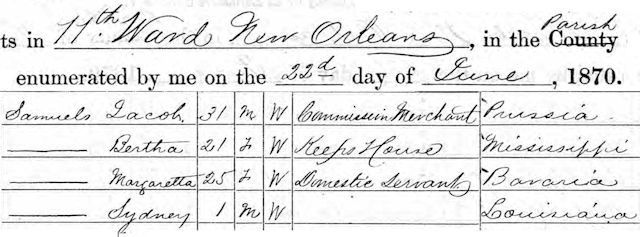 By 1869 Jacob was again living in New Orleans, where he married Bertha Wadel, the daughter of Prussian Jewish immigrants. Their son Sidney Lionel was born in 1869.
By 1869 Jacob was again living in New Orleans, where he married Bertha Wadel, the daughter of Prussian Jewish immigrants. Their son Sidney Lionel was born in 1869.

By 1880 Jacob was back in Fort Worth with his family, living on Houston Street. Sidney and brother Bertrand were in school.
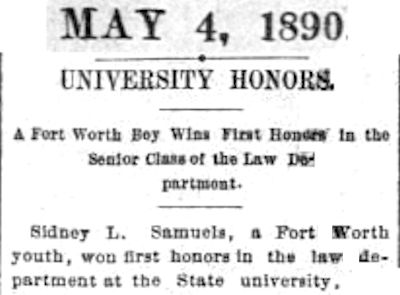 Sidney attended Fort Worth University, graduated from the University of Texas law school with honors in 1890, started his law practice in Fort Worth in 1892.
Sidney attended Fort Worth University, graduated from the University of Texas law school with honors in 1890, started his law practice in Fort Worth in 1892.
 In 1892 Sidney—attorney and notary public—was living with his parents and siblings on East Belknap Street just west of today’s railroad overpass.
In 1892 Sidney—attorney and notary public—was living with his parents and siblings on East Belknap Street just west of today’s railroad overpass.
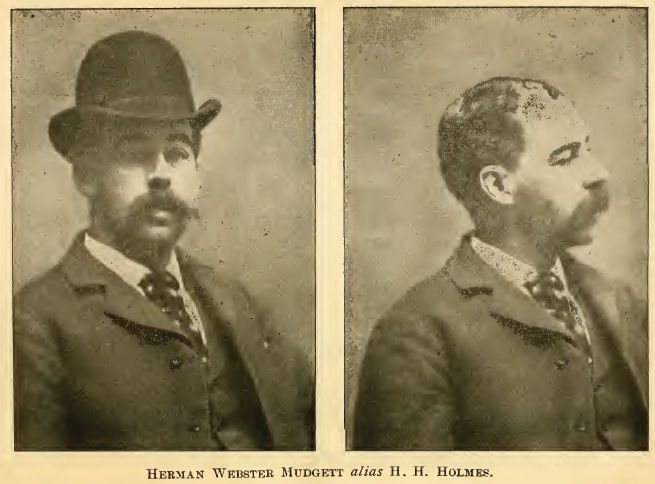 And then Herman Webster Mudgett came to town.
And then Herman Webster Mudgett came to town.
Herman Webster Mudgett, alias Dr. Henry Howard Holmes, has been called America’s first serial killer (he confessed to twenty-seven). Holmes had first come to Fort Worth in 1893 to cheat Minnie Williams and her sister Annie out of their inheritance—two hundred feet of prime frontage on East 2nd Street downtown. (More about Holmes’s surreal career of murder and fraud can be read here and here and here and here.)
Holmes was back in Fort Worth in 1894 when he defrauded Mrs. Carrie Pitezel. She was the wife of Benjamin Pitezel. Pitezel was Holmes’s accomplice in other fraud schemes. Holmes would later murder Pitezel. And be suspected of murdering three of the Pitezel children. And of planning to murder Mrs. Pitezel after getting as much of her money as he could.
H. H. Holmes did nothing by halves.
While Holmes was in Fort Worth, he met young attorney Sidney Samuels and Sidney’s brother Bertrand, who was a collections clerk at Farmers and Mechanics National Bank.
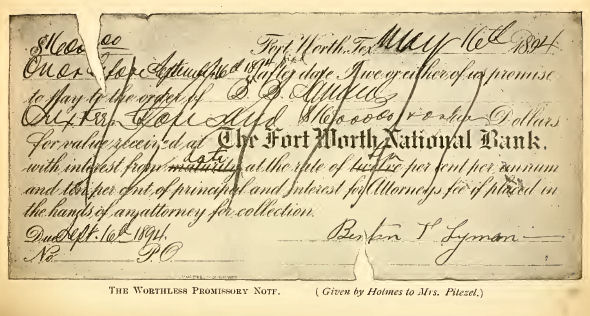 Holmes (using the alias Pratt) persuaded Bertrand to lend $16,000 ($431,000 today) to Benton T. Lyman (Pitezel’s alias) and persuaded Sidney to write the promissory note. Holmes later went back to Sidney, claimed he had lost the note, persuaded Sidney to lend Benton T. Lyman (Pitezel) $2,500 on a new promissory note, and used the first note—worthless because Pitezel had never endorsed it—to cheat Mrs. Pitezel out of $5,000.
Holmes (using the alias Pratt) persuaded Bertrand to lend $16,000 ($431,000 today) to Benton T. Lyman (Pitezel’s alias) and persuaded Sidney to write the promissory note. Holmes later went back to Sidney, claimed he had lost the note, persuaded Sidney to lend Benton T. Lyman (Pitezel) $2,500 on a new promissory note, and used the first note—worthless because Pitezel had never endorsed it—to cheat Mrs. Pitezel out of $5,000.
Then, for good measure, Holmes murdered Mr. Pitezel.
By 1895 Holmes had become ensnared in his web of murder and deception and was put on trial for killing Pitezel. Sidney Samuels, at his own expense, traveled to Philadelphia to testify against Holmes. Samuels was twenty-six years old.
 Samuels, with “twinkling eye” and “perfect self-possession,” testified against “the individual” who had been building a “three-story structure” in Fort Worth at the corner of East 2nd and Commerce streets—the property he had gotten from the Williams sisters.
Samuels, with “twinkling eye” and “perfect self-possession,” testified against “the individual” who had been building a “three-story structure” in Fort Worth at the corner of East 2nd and Commerce streets—the property he had gotten from the Williams sisters.
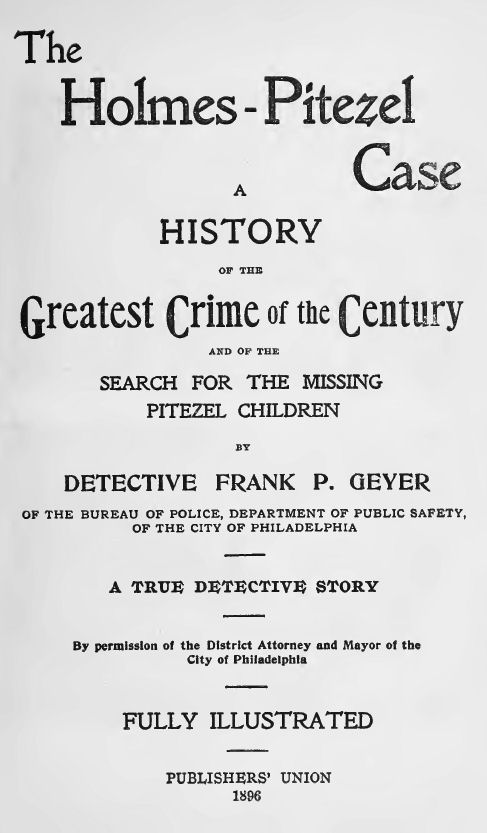 Frank P. Geyer, a Philadelphia police detective, in 1896 wrote a book about his investigation of “the greatest crime of the century.” Geyer wrote of the testimony of Sidney Samuels in 1895:
Frank P. Geyer, a Philadelphia police detective, in 1896 wrote a book about his investigation of “the greatest crime of the century.” Geyer wrote of the testimony of Sidney Samuels in 1895:
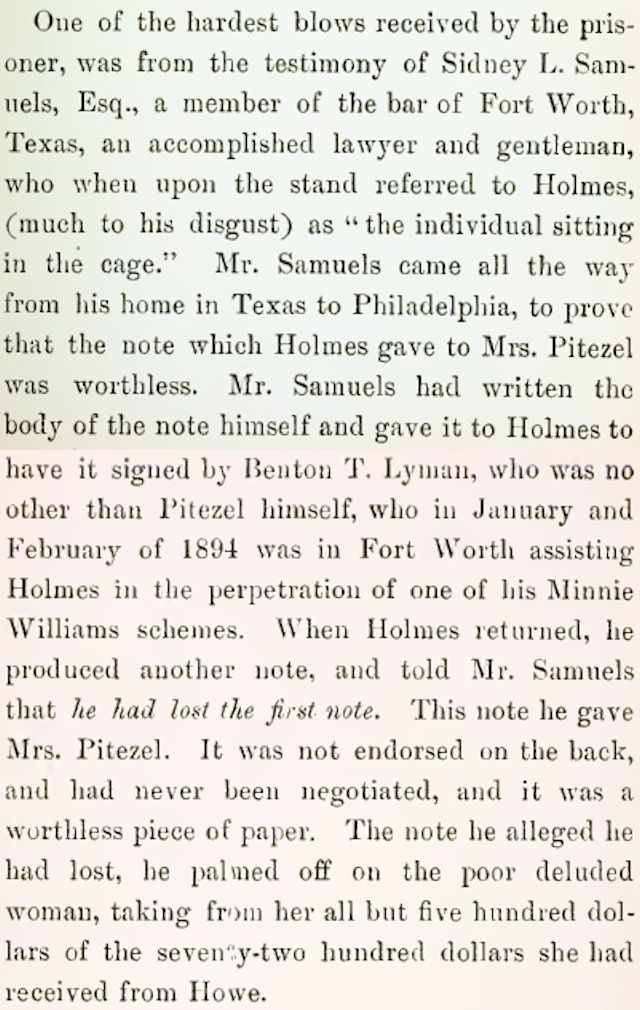
“One of the hardest blows received by the prisoner, was from the testimony of Sidney L. Samuels, Esq., a member of the bar of Fort Worth, Texas . . . who . . . referred to Holmes (much to his disgust) as ‘the individual sitting in the cage.'” A cage (or dock, from the Flemish dok meaning “pen or cage for animals”) was a place of confinement for defendants while in a courtroom. The dock was sometimes made of iron bars, sometimes of wood and glass.
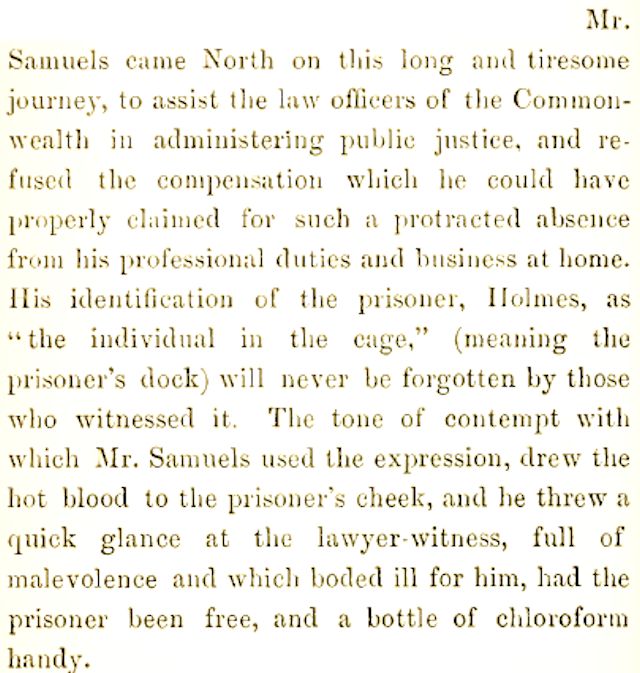 Geyer wrote that Samuels’s “identification of the prisoner, Holmes, as ‘the individual in the cage,’ (meaning the prisoner’s dock) will never be forgotten by those who witnessed it. The tone of contempt with which Mr. Samuels used the expression, drew the hot blood to the prisoner’s cheek, and he threw a quick glance at the lawyer-witness, full of malevolence and which boded ill for him, had the prisoner been free, and a bottle of chloroform handy.”
Geyer wrote that Samuels’s “identification of the prisoner, Holmes, as ‘the individual in the cage,’ (meaning the prisoner’s dock) will never be forgotten by those who witnessed it. The tone of contempt with which Mr. Samuels used the expression, drew the hot blood to the prisoner’s cheek, and he threw a quick glance at the lawyer-witness, full of malevolence and which boded ill for him, had the prisoner been free, and a bottle of chloroform handy.”
Holmes had used chloroform to murder Pitezel.
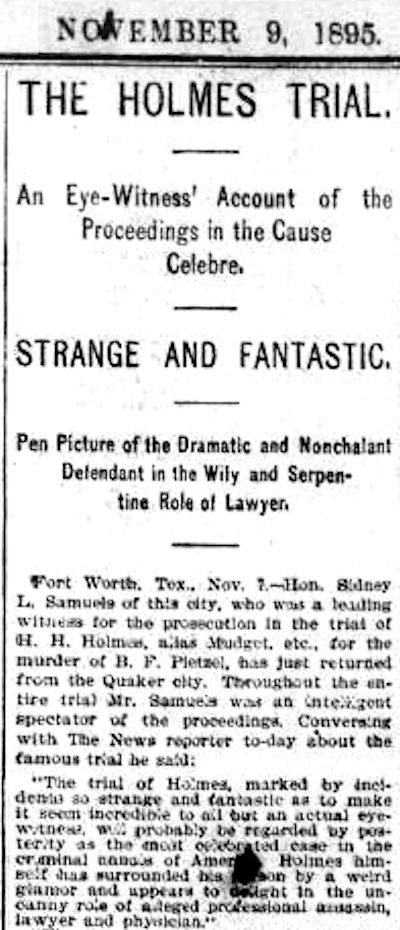 After returning to Fort Worth from Philadelphia, Samuels told a reporter of the Galveston Daily News that the Holmes trial “will probably be regarded by posterity as the most celebrated case in the criminal annals of America.”
After returning to Fort Worth from Philadelphia, Samuels told a reporter of the Galveston Daily News that the Holmes trial “will probably be regarded by posterity as the most celebrated case in the criminal annals of America.”
Herman Webster Mudgett, alias Henry Howard Holmes, was convicted and was hanged in 1896 for the murder of Benjamin Pitezel.
After his Holmes testimony, Sidney Lionel Samuels practiced law in Fort Worth for another half-century. He would be Fort Worth city attorney from 1907 to 1909, sit on the bench of the Texas Supreme Court as special chief justice in a case involving twenty-eight thousand acres of public grazing land in the Panhandle. He would be the personal attorney of Burk Burnett and Amon Carter. His law firm would represent the Star-Telegram for forty-one years. An expert in libel law, he would co-author the state’s “privilege” law that allows newspapers to publish courtroom testimony. During World War I he would head the state draft board. President Woodrow Wilson would ask him to be ambassador to Luxembourg. Sidney Lionel Samuels would decline and stay in Fort Worth.
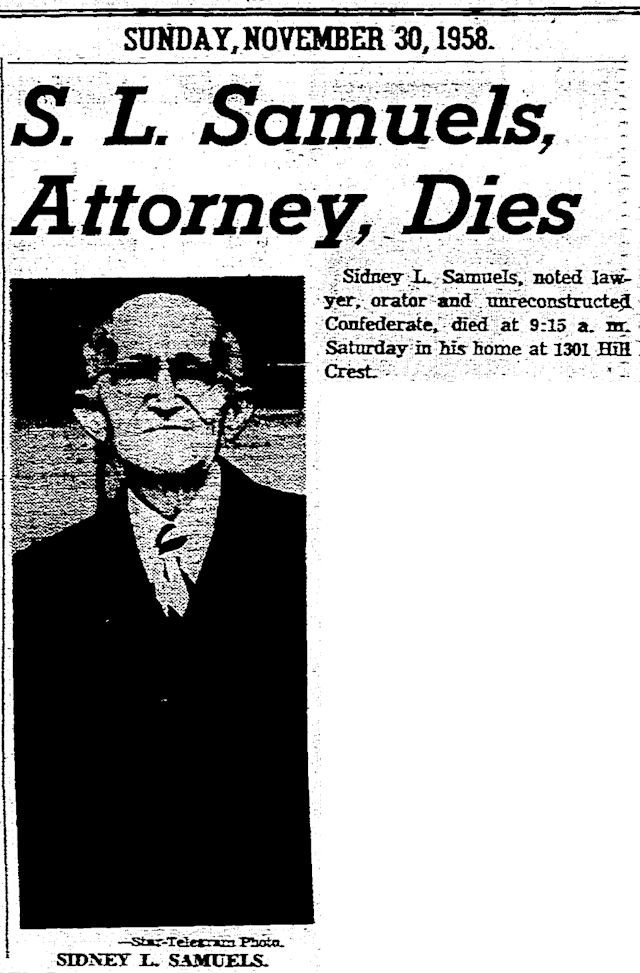
Sidney Lionel Samuels died on November 29, 1958. What changes he saw during his lifetime. For example, when he testified against “the individual sitting in the cage” people traveled long distances by steam locomotive; when he died people traveled long distances by jet airplane (the Boeing 707 was introduced in October 1958).
Samuels’s obituary in the Star-Telegram referred to him as an “unreconstructed Confederate.” He was proud of his family’s southern ties. His mother was born in Mississippi; his father Jacob had enlisted in the Confederate army in 1861 when J. C. Terrell organized a unit of volunteers. Jacob served under General Tom Green, for whom the Texas county is named. Sidney always regretted that the North had won the Civil War. He advocated “a leisure class, a class unprivileged but with the aristocracy of intelligence, pledged to the service of the people and the state, something comparable to the gentry of the Old South.”
The obituary did not mention Samuels’s role in the trial of the “greatest crime of the century.”
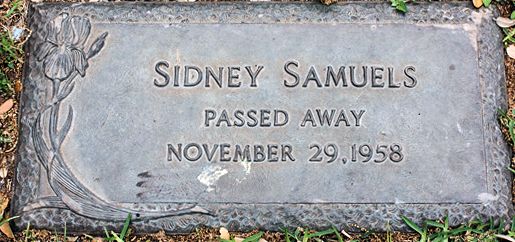
Sidney Lionel Samuels is buried in Greenwood Cemetery.






Fascinating story is right! I’m 79, born here, and never heard any of this tale. Wow!
Thank you for all this research. Great site.
Great story…until today had not heard about this history of Ft. Worth. Thx for the post.
Thanks, John. I still remember how far my jaw dropped when I first found out about this story.
As always Mike, great site. I’ve been looking into the Holmes case for a while and still researching. Thanks for the unknown help…..
Thanks, Dale. It’s a fascinating story. First for the facts themselves, no matter where they took place. Second for the Fort Worth connection. Third for the fact that the story is not better known locally.